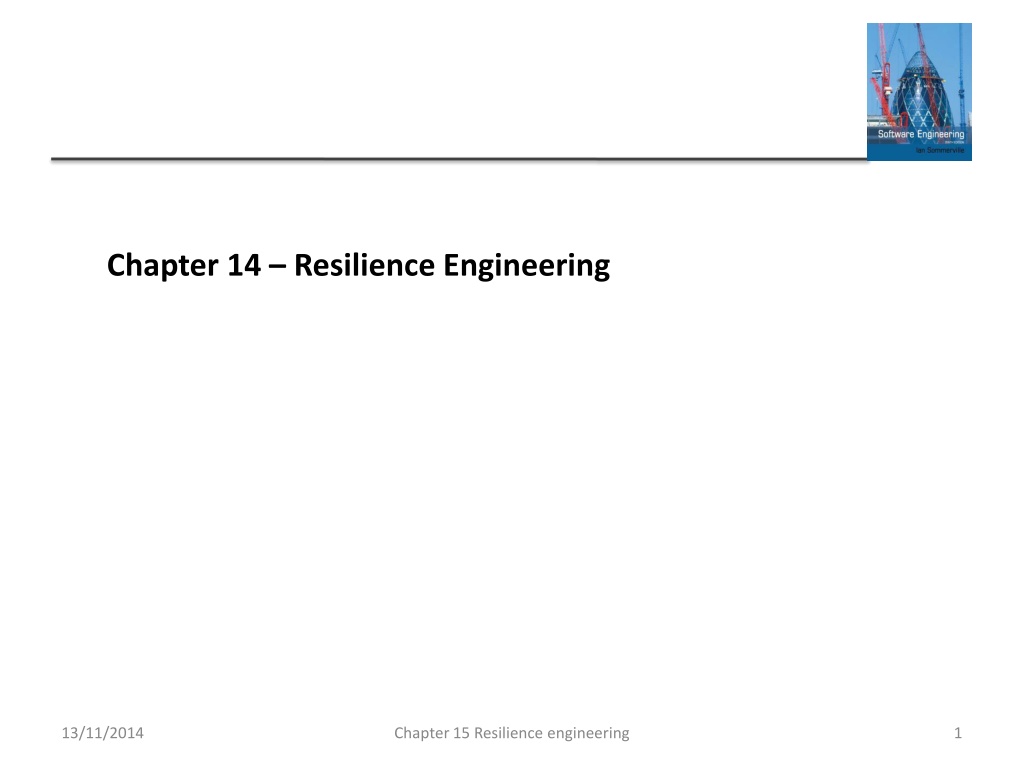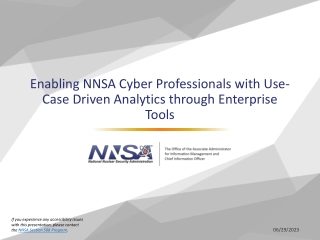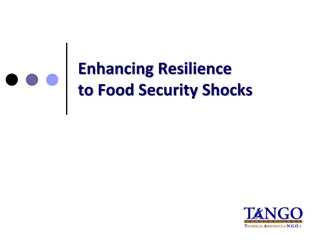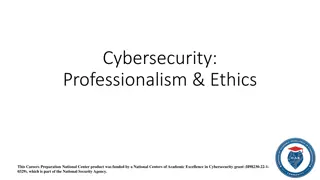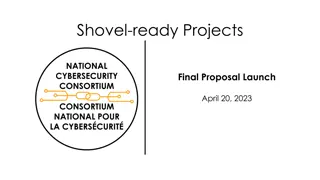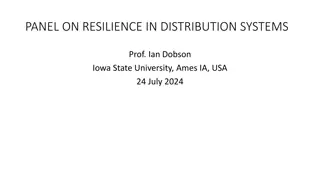Understanding Resilience Engineering in Cybersecurity Systems
Resilience engineering focuses on how well a system can maintain critical services during disruptive events like cyberattacks. It emphasizes the judgment of system resilience, essential ideas, assumptions, and activities for recognition, resistance, recovery, and reinstatement. The goal is to limit costs of failures and recover quickly to ensure normal system operation.
Download Presentation

Please find below an Image/Link to download the presentation.
The content on the website is provided AS IS for your information and personal use only. It may not be sold, licensed, or shared on other websites without obtaining consent from the author. Download presentation by click this link. If you encounter any issues during the download, it is possible that the publisher has removed the file from their server.
E N D
Presentation Transcript
Chapter 14 Resilience Engineering 13/11/2014 Chapter 15 Resilience engineering 1
Topics covered Cybersecurity Sociotechnical resilience Resilient systems design 13/11/2014 Chapter 15 Resilience engineering 2
Resilience The resilience of a system is a judgment of how well that system can maintain the continuity of its critical services in the presence of disruptive events, such as equipment failure and cyberattacks. Cyberattacks by malicious outsiders are perhaps the most serious threat faced by networked systems but resilience is also intended to cope with system failures and other disruptive events. 13/11/2014 Chapter 15 Resilience engineering 3
Essential resilience ideas The idea that some of the services offered by a system are critical services whose failure could have serious human, social or economic effects. The idea that some events are disruptive and can affect the ability of a system to deliver its critical services. The idea that resilience is a judgment there are no resilience metrics and resilience cannot be measured. The resilience of a system can only be assessed by experts, who can examine the system and its operational processes. 13/11/2014 Chapter 15 Resilience engineering 4
Resilience engineering assumptions Resilience engineering assumes that it is impossible to avoid system failures and so is concerned with limiting the costs of these failures and recovering from them. Resilience engineering assumes that good reliability engineering practices have been used to minimize the number of technical faults in a system. It therefore places more emphasis on limiting the number of system failures that arise from external events such as operator errors or cyberattacks. 13/11/2014 Chapter 15 Resilience engineering 5
Resilience activities Recognition The system or its operators should recognise early indications of system failure. Resistance If the symptoms of a problem or cyberattack are detected early, then resistance strategies may be used to reduce the probability that the system will fail. Recovery If a failure occurs, the recovery activity ensures that critical system services are restored quickly so that system users are not badly affected by failure. Reinstatement In this final activity, all of the system services are restored and normal system operation can continue. 13/11/2014 Chapter 15 Resilience engineering 6
Resistance Resistance strategies may focus on isolating critical parts of the system so that they are unaffected by problems elsewhere. Resistance includes proactive resistance where defences are included in a system to trap problems and reactive resistance where actions are taken when a problem is discovered. 13/11/2014 Chapter 15 Resilience engineering 7
Resilience activities 13/11/2014 Chapter 15 Resilience engineering 8
Cybersecurity 13/11/2014 Chapter 15 Resilience engineering 9
Cybersecurity Cybercrime is the illegal use of networked systems and is one of the most serious problems facing our society. Cybersecurity is a broader topic than system security engineering Cybersecurity is a sociotchnical issue covering all aspects of ensuring the protection of citizens, businesses and critical infrastructures from threats that arise from their use of computers and the Internet. Cybersecurity is concerned with all of an organization s IT assets from networks through to application systems. 13/11/2014 Chapter 15 Resilience engineering 10
Factors contributing to cybersecurity failure organizational ignorance of the seriousness of the problem, poor design and lax application of security procedures, human carelessness, inappropriate trade-offs between usability and security. 13/11/2014 Chapter 15 Resilience engineering 11
Cybersecurity threats Threats to the confidentiality of assets Data is not damaged but it is made available to people who should not have access to it. Threats to the integrity of assets These are threats where systems or data are damaged in some way by a cyberattack. Threats to the availability of assets These are threats that aim to deny use of assets by authorized users. 13/11/2014 Chapter 15 Resilience engineering 12
Examples of controls Authentication, where users of a system have to show that they are authorized to access the system Encryption, where data is algorithmically scrambled so that an unauthorized reader cannot access the information. Firewalls, where incoming network packets are examined then accepted or rejected according to a set of organizational rules. Firewalls can be used to ensure that only traffic from trusted sources is passed from the external Internet into the local organizational network. 13/11/2014 Chapter 15 Resilience engineering 13
Redundancy and diversity Copies of data and software should be maintained on separate computer systems. This supports recovery after a successful cyberattack. (recovery and reinstatement) Multi-stage diverse authentication can protect against password attacks. This is a resistance measure Critical servers may be over-provisioned i.e. they may be more powerful than is required to handle their expected load. Attacks can be resisted without serious service degradation. 13/11/2014 Chapter 15 Resilience engineering 14
Cyber-resilience planning 13/11/2014 Chapter 15 Resilience engineering 15
Cyber resilience planning Asset classification The organization s hardware, software and human assets are examined and classified depending on how essential they are to normal operations. Threat identification For each of the assets (or, at least the critical and important assets), you should identify and classify threats to that asset. Threat recognition For each threat or, sometimes asset/threat pair, you should identify how an attack based on that threat might be recognised. 13/11/2014 Chapter 15 Resilience engineering 16
Cyber resilience planning Threat resistance For each threat or asset/threat pair, you should identify possible resistance strategies. These may be either embedded in the system (technical strategies) or may rely on operational procedures. Asset recovery For each critical asset or asset/threat pair, you should work out how that asset could be recovered in the event of a successful cyberattack. Asset reinstatement This is a more general process of asset recovery where you define procedures to bring the system back into normal operation. 13/11/2014 Chapter 15 Resilience engineering 17
Sociotechnical resilience 13/11/2014 Chapter 15 Resilience engineering 18
Sociotechnical resilience Resilience engineering is concerned with adverse external events that can lead to system failure. To design a resilient system, you have to think about sociotechnical systems design and not exclusively focus on software. Dealing with these events is often easier and more effective in the broader sociotechnical system. 13/11/2014 Chapter 15 Resilience engineering 19
Mentcare example Cyberattack may aim to steal data, gaining access using a legitimate user s credentials Technical solution may be to use more complex authentication procedures. These irritate users and may reduce security as users leave systems unattended without logging out. A better strategy may be to introduce organizational policies and procedures that emphasise the importance of not sharing login credentials and that tell users about easy ways to create and maintain strong passwords. 13/11/2014 Chapter 15 Resilience engineering 20
Nested technical and sociotechnical systems 13/11/2014 Chapter 15 Resilience engineering 21
Failure hierarchy A failure in system S1 may be trapped in the broader sociotechnical system ST1 through operator actions Organizational damage is therefore limited If the failure in S1 leads to a failure in ST1, then it is up to managers in the broader organization to deal with that failure. 13/11/2014 Chapter 15 Resilience engineering 22
Characteristics of resilient organizations 13/11/2014 Chapter 15 Resilience engineering 23
Organizational resilience There are four characteristics that reflect the resilience of an organization Responsiveness, monitoring, anticipation, learning The ability to respond Organizations have to be able to adapt their processes and procedures in response to risks. These risks may be anticipated risks or may be detected threats to the organization and its systems. The ability to monitor Organizations should monitor both their internal operations and their external environment for threats before they arise. 13/11/2014 Chapter 15 Resilience engineering 24
Organizational resilience The ability to anticipate A resilient organization should not simply focus on its current operations but should anticipate possible future events and changes that may affect its operations and resilience. The ability to learn Organizational resilience can be improved by learning from experience. It is particularly important to learn from successful responses to adverse events such as the effective resistance of a cyberattack. Learning from success allows 13/11/2014 Chapter 15 Resilience engineering 25
Human error People inevitably make mistakes (human errors) that sometimes lead to serious system failures. There are two ways to consider human error The person approach. Errors are considered to be the responsibility of the individual and unsafe acts (such as an operator failing to engage a safety barrier) are a consequence of individual carelessness or reckless behaviour. The systems approach. The basic assumption is that people are fallible and will make mistakes. People make mistakes because they are under pressure from high workloads, poor training or because of inappropriate system design. 13/11/2014 Chapter 15 Resilience engineering 26
Systems approach Systems engineers should assume that human errors will occur during system operation. To improve the resilience of a system, designers have to think about the defences and barriers to human error that could be part of a system. Can these barriers should be built into the technical components of the system (technical barriers)? If not, they could be part of the processes, procedures and guidelines for using the system (sociotechnical barriers). 13/11/2014 Chapter 15 Resilience engineering 27
Defensive layers 13/11/2014 Chapter 15 Resilience engineering 28
Defensive layers You should use redundancy and diversity to create a set of defensive layers, where each layer uses a different approach to deter attackers or trap technical/human failures. ATC system examples Conflict alert system Formalized recording procedures Collaborative checking 13/11/2014 Chapter 15 Resilience engineering 29
Reasons Swiss Cheese Model 13/11/2014 Chapter 15 Resilience engineering 30
Swiss Cheese model Defensive layers have vulnerabilities They are like slices of Swiss cheese with holes in the layer corresponding to these vulnerabilities. Vulnerabilities are dynamic The holes are not always in the same place and the size of the holes may vary depending on the operating conditions. System failures occur when the holes line up and all of the defenses fail. 13/11/2014 Chapter 15 Resilience engineering 31
Increasing system resilience Reduce the probability of the occurrence of an external event that might trigger system failures. Increase the number of defensive layers. The more layers that you have in a system, the less likely it is that the holes will line up and a system failure occur. Design a system so that diverse types of barriers are included. The holes will probably be in different places and so there is less chance of the holes lining up and failing to trap an error. Minimize the number of latent conditions in a system. This means reducing the number and size of system holes . 13/11/2014 Chapter 15 Resilience engineering 32
Operational and management processes All software systems have associated operational processes that reflect the assumptions of the designers about how these systems will be used. For example, in an imaging system in a hospital, the operator may have the responsibility of checking the quality of the images immediately after these have been processed. This allows the imaging procedure to be repeated if there is a problem. 13/11/2014 Chapter 15 Resilience engineering 33
Operational processes Operational processes are the processes that are involved in using the system for its defined purpose. For new systems, these operational processes have to be defined and documented during the system development process. Operators may have to be trained and other work processes adapted to make effective use of the new system. 13/11/2014 Chapter 15 Resilience engineering 34
Personal and Enterprise IT processes For personal systems, the designers may describe the expected use of the system but have no control over how users will actually behave. For enterprise IT systems, however, there may be training for users to teach them how to use the system. Although user behaviour cannot be controlled, it is reasonable to expect that they will normally follow the defined process. 13/11/2014 Chapter 15 Resilience engineering 35
Process design Operational and management processes are an important defense mechanism and, in designing a process, you need to find a balance between efficient operation and problem management. Process improvement focuses on identifying and codifying good practice and developing software to support this. If process improvement focuses on efficiency, then this can make it more difficult to deal with problems when these arise. 13/11/2014 Chapter 15 Resilience engineering 36
Efficiency and resilience Efficient process operation Problem management Process optimization and control Process flexibility and adaptability Information hiding and security Information sharing and visibility Automation to reduce operator workload with fewer operators and managers Role specialization Manual processes and spare operator/manager capacity to deal with problems Role sharing 13/11/2014 Chapter 15 Resilience engineering 37
Coping with failures What seems to be inefficient practice often arises because people maintain redundant information or share information because they know this makes it easier to deal with problems when things go wrong. When things go wrong, operators and system managers can often recover the situation although this may sometimes mean that they have to break rules and work around the defined process. You should therefore design operational processes to be flexible and adaptable. 13/11/2014 Chapter 15 Resilience engineering 38
Information provision and management To make a process more efficient, it may make sense to present operators with the information that they need, when they need it. If operators are only presented with information that the process designer thinks that they need to know then they may be unable to detect problems that do not directly affect their immediate tasks. When things go wrong, the system operators do not have a broad picture of what is happening in the system, so it is more difficult for them to formulate strategies for dealing with problems. 13/11/2014 Chapter 15 Resilience engineering 39
Process automation Process automation can have both positive and negative effects on system resilience. If the automated system works properly, it can detect problems, invoke cyberattack resistance if necessary and start automated recovery procedures. However, if the problem can t be handled by the automated system, there are fewer people available to tackle the problem and the system may have been damaged by the process automation doing the wrong thing. 13/11/2014 Chapter 15 Resilience engineering 40
Disadvantages of process automation Automated management systems may go wrong and take incorrect actions. As problems develop, the system may take unexpected actions that make the situation worse and which cannot be understood by the system managers. Problem solving is a collaborative process. If fewer managers are available, it is likely to take longer to work out a strategy to recover from a problem or cyberattack. 13/11/2014 Chapter 15 Resilience engineering 41
Resilient systems design 13/11/2014 Chapter 15 Resilience engineering 42
Resilient systems design Identifying critical services and assets Critical services and assets are those elements of the system that allow a system to fulfill its primary purpose. For example, the critical services in a system that handles ambulance dispatch are those concerned with taking calls and dispatching ambulances. Designing system components that support problem recognition, resistance, recovery and reinstatement For example, in an ambulance dispatch system, a watchdog timer may be included to detect if the system is not responding to events. 13/11/2014 Chapter 15 Resilience engineering 43
Survivable systems analysis System understanding For an existing or proposed system, review the goals of the system (sometimes called the mission objectives), the system requirements and the system architecture. Critical service identification The services that must always be maintained and the components that are required to maintain these services are identified. 13/11/2014 Chapter 15 Resilience engineering 44
Survivable systems analysis Attack simulation Scenarios or use cases for possible attacks are identified along with the system components that would be affected by these attacks. Survivability analysis Components that are both essential and compromisable by an attack are identified and survivability strategies based on resistance, recognition and recovery are identified. 13/11/2014 Chapter 15 Resilience engineering 45
Stages in survivability analysis 13/11/2014 Chapter 15 Resilience engineering 46
Problems for business systems The fundamental problem with this approach to survivability analysis is that its starting point is the requirements and architecture documentation for a system. However for business systems: It is not explicitly related to the business requirements for resilience. I believe that these are a more appropriate starting point than technical system requirements. It assumes that there is a detailed requirements statement for a system. In fact, resilience may have to be retrofitted to a system where there is no complete or up-to-date requirements document. 13/11/2014 Chapter 15 Resilience engineering 47
Resilience engineering 13/11/2014 Chapter 15 Resilience engineering 48
Streams of work in resilience engineering Identify business resilience requirements Plan how to reinstate systems to their normal operating state Identify system failures and cyberattacks that can compromise a system Plan how to recover critical services quickly after damage or a cyberattack Test all aspects of resilience planning 13/11/2014 Chapter 15 Resilience engineering 49
Maintaining critical service availability To maintain availability, you need to know: the system services that are the most critical for a business, the minimal quality of service that must be maintained, how these services might be compromised, how these services can be protected, how you can recover quickly if the services become unavailable. Critical assets are identified during service analysis. Assets may be hardware, software, data or people. 13/11/2014 Chapter 15 Resilience engineering 50
